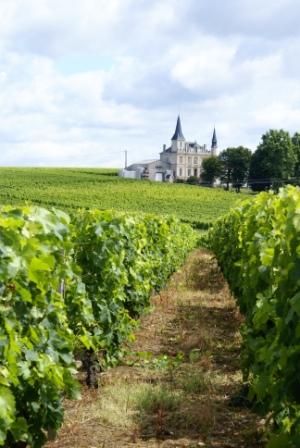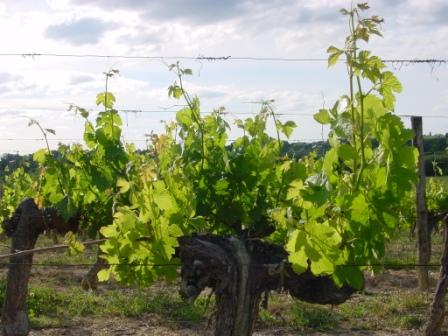| Alsace | Bordeaux | Burgundy | Champagne | Loire Valley | Rhône Valley |
- A relatively humid region on the Atlantic coast of France
- Produces mostly blended reds, from Cabernet Sauvignon, Merlot , Cabernet Franc, Petit Verdot and Malbec
- Cabernet Sauvignon (Bordeaux’s second-most planted grape variety) dominates the blend in red wines produced in the left bank of the Gironde estuary
- Merlot (Bordeaux’s most-planted grape variety) tend to dominate the right bank appellation blends
- The Gironde is a navigable estuary in southwest France and is formed from the meeting of the rivers Dordogne and Garonne just below the centre of Bordeaux
- White Bordeaux is predominantly made from Sémillon, Sauvignon Blanc and Muscadelle – (Typical blends are usually 80% Sémillon, 20
 % Sauvignon Blanc)
% Sauvignon Blanc) - Other permitted grape varieties of White Bordeaux are Ugni Blanc, Colombard, Merlot Blanc, Ondenc and Mauzac
- The use of chaptalization, the addition of sugar, is common in Bordeaux, except in the warmest of vintages, and especially on the left bank
- Use of concentrators, where a winemaker can remove water from the must, is common in Bordeaux (some producers highly oppose this practice)
- Many also use the method of micro-oxygenation, where microscopic amounts of oxygen are added to the wine during fermentation to stabilize (green) tannins and anthocyanins (also used during élevage, as a way of avoiding racking and controlling the amount of oxygen applied to the wine)
- The addition of oak chips (to add an oaky flavor to the wine) has been made legal in Bordeaux
Red Bordeaux and Bordeaux Supérieur:
- Allowed to be produced all over the region, and represent the cheapeast Bordeaux wines
- These wines tend to be fruity and meant to be drunk young
- Bordeaux Supérieur requires a higher alcohol level than basic Bordeaux AC
- Red Côtes de Bordeaux:
- Eight appellations are in the outskirts of the region
- Produce wines where the blend usually is dominated by Merlot
- Tend to be moderate in price
- Red Libourne, or “Right Bank” wines:
- 10 appellations located around the city of Libourne
- Wines dominated by Merlot with very little Cabernet Sauvignon (most Cabernet Franc grown here)
- These wines often have great fruit concentration, softer tannins and age well
- Subregions of Saint-Émilion, Pomerol, Bourg and Blaye
- Saint-Émilion has heirarchy created in 1955, all within the separate Saint-Émilion Grand Cru AC
- Saint-Émilion ascending order are Grand Cru, Grand Cru Classe, and Premier Grand Cru Classe
- Pomerol has no formal classification ( well known names of Petrus and Le Pin)
- “Left Bank” wines:
- West and south of the Gironde and Garrone
- Areas of Medoc, Haut-Medoc, and Graves (listed north to south)
- Reds wines dominated by Cabernet Sauvignon; often with a significant portion of Merlot and some Cabernet Franc
- These wines are concentrated, tannic, and most meant to be cellared before drinking
- The Haut-Medoc contains 4 of the 5 “First Growths” (Saint-Estephe, Pauillac, Saint-Julien, and Margaux)
- Graves has whites and reds, with the best listed as ‘Cru Classe’ (all the Cru Classe are located in Pessac-Leognan commune)
- Chateau Haut-Brion (located in Graves) is the only first growth outside of the Haut-Medoc
- Graves also contains 2 communes well know ofr sweet white wines: Sauternes and Barsac
- Dry white wines:
- Blends dominated by Sauvignon Blanc and Sémillon
- Most well-known from Graves
- Better versions tend to have a significant oak influence
- Sweet white wines:
- Made from Sémillon, Savignon Blanc and Muscadelle grapes affected by noble rot
- The best-known of these appellations is Sauternes
- Also appellations neighboring Sauternes, on both sides of the Garonne river, where similar wines are made
- Bordeaux Wine Official Classification of 1855 :
- Came about due to Emperor Napoleon III request for a classification system for France’s best Bordeaux wines
- All of the red wines that made it on the list came from the Médoc region except for one: Château Haut-Brion from Graves
- Only a few changes made from then until present
- Many wine critics have argued that the 1855 Classification became outdated and does not provide an accurate guide to the quality of the wines being made on each estate
- From most important: (for red wines)
- First Growths (Premiers or 1er Crus) 5
- Second Growths (officially Seconds Crus, sometimes written as Deuxièmes Crus) 14
- Third Growths (Troisièmes Crus) 14
- Fourth Growths (Quatrièmes Crus) 10
- Fifth Growths (Cinquièmes Crus) 18
- Sauternes and Barsac: (for white wines)
- Superior First Growth (Premier Grand Cru Classe)-only one is Chateau d’Yquem
- First Growths (Premiers Crus) 11
- Second Growths (Deuxièmes Crus) 14
- Classification of St.-Émilion wine:

- In 1955 the wines of Saint-Émilion in the wine-growing region of Bordeaux were first classified
- The Saint-Émilion list is updated every 10 years or so, unlike the Bordeaux Wine Official Classification of 1855
- Possibility for promotion and demotion
- Covering wines from the Medoc and Graves regions
- As of 2006, comprised of 13 Premiers grands crus classés and 53 Grands crus classés
- Over two hundred other Saint-Émilion wines carry the description “Grand Cru”, but are not seen as being of comparable quality to the Grand Cru Classés

 Masters of Wine
Masters of Wine Wine and Spirits Education Trust
Wine and Spirits Education Trust